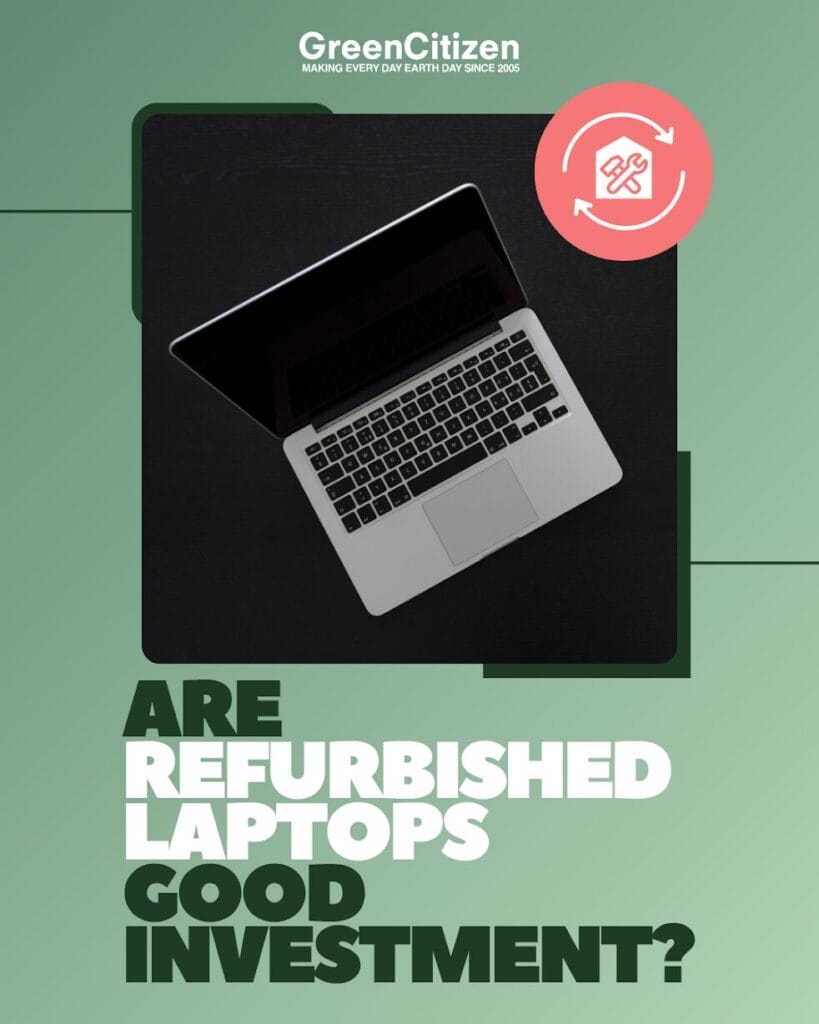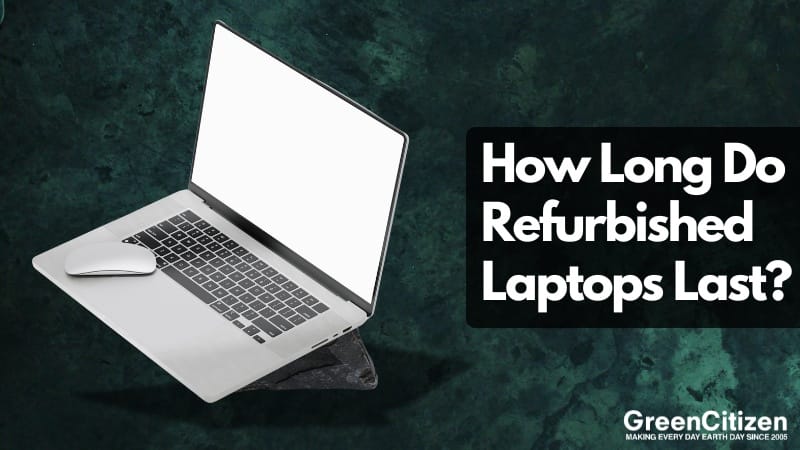Refurbished laptops can last nearly as long as new ones, but the difference comes down to age, quality of refurbishment, and how the device is used. A new laptop typically lasts 4 to 6 years, while a refurbished one averages 3 to 5 years.
The gap often narrows when the refurbished unit is certified, upgraded with an SSD, or given a fresh battery.
In this guide, we’ll break down the average lifespan of both new and refurbished laptops, what factors affect durability, and how to make your refurbished device last longer.
Key Takeaway: How Long Do Refurbished Laptops Last Compared to Brand New Ones?
New laptops last about 4–6 years, while refurbished laptops average 3–5 years. The gap narrows with certified models that include fresh batteries and SSD upgrades, offering nearly the same reliability at lower cost. For long-term value and sustainability, refurbished laptops are often the smarter choice.

Green Store by GreenCitizen
- Over 350,000 customers served
- 99.3% positive feedback
Professionally tested, cleaned, and prepared
What Is the Average Lifespan of a New Laptop?
A typical new laptop lasts about 4 to 6 years before slowing down or becoming outdated. Budget laptops often wear out faster (3–4 years), while well-built business or premium models can stretch closer to 6 years with good care.
Several factors affect lifespan:
- Build materials: Laptops with aluminum or magnesium alloy chassis withstand daily use better than plastic-bodied devices, which flex, crack, and wear out faster.
- Cooling design: Efficient cooling systems — like dual fans, vapor chambers, well-placed vents, and high-quality thermal pads — prevent overheating and extend component life. Poor thermal management accelerates failure.
- Usage type: Office tasks or web browsing put less stress on components compared to 3D rendering, video editing, or gaming. Gaming laptops, despite powerful specs, often last 3–5 years due to heavy heat output and rapid GPU/CPU obsolescence.
- Maintenance: Cleaning dust from vents, using cooling pads, and replacing thermal paste help keep laptops performing longer.
👉 Summary: Most new laptops last around five years with regular use. Budget models may fail sooner, while premium devices with strong materials and efficient cooling can reach the 6-year mark. Gaming laptops, however, typically run hotter and become obsolete faster, lasting closer to 3–5 years.
How Long Do Refurbished Laptops Last on Average?
Refurbished laptops typically last 3 to 5 years, but their lifespan depends on who refurbished them and what parts were replaced. Certified refurbished models — often upgraded with a new battery, SSD, or RAM — can perform nearly like new and reach the 4 to 5 year range.
In contrast, uncertified or low-cost refurbished laptops, where only cosmetic fixes are done, may fail in as little as 2 to 3 years.
Still,
| Refurbished Laptop Type | Average Lifespan |
|---|---|
| Certified Refurbished | 4–5 years |
| Business-Grade Refurbished | 4–5 years |
| Uncertified / Low-Cost Refurbished | 2–3 years |
Do Refurbished Laptops Last as Long as New Ones?
Refurbished laptops generally do not last quite as long as new ones, but the gap is often smaller than most people think. A new laptop usually lasts 4 to 6 years, while a refurbished model averages 3 to 5 years.
That means the difference is typically 1 to 2 years in usable lifespan.
| Laptop Type | Average Lifespan | Notes |
|---|---|---|
| New Laptop | 4–6 years | Full component life, brand-new battery |
| Certified Refurbished | 4–5 years | Close to new, often with SSD + battery replacement |
| Uncertified Refurbished | 2–3 years | Higher risk of failure, minimal refurbishment |
What Closes the Gap?
- Certified refurbishment: Devices tested and repaired by the manufacturer or an authorized vendor last far longer than uncertified ones.
- Component upgrades: SSD and RAM replacements and fresh batteries extend performance and reliability.
- Business-grade models: Enterprise laptops built with aluminum or magnesium chassis age more gracefully than plastic consumer laptops.
- Good maintenance: Cleaning dust, avoiding overheating, and careful charging habits add years to any laptop.

👉 Key Takeaway: New laptops usually last 1–2 years longer than refurbished ones. But when refurbished through a certified program with upgraded parts, they can deliver nearly the same reliability and lifespan at a lower cost.
What Affects the Lifespan of a Refurbished Laptop?
A refurbished laptop’s longevity depends heavily on the quality of its components and upgrades during refurbishment. Some parts naturally degrade, while others become bottlenecks as software demands rise.
Battery Replacement
Lithium-ion batteries degrade faster than almost any other component. Most are rated for 300–500 full charge cycles before losing 20–30% of capacity. A certified refurbisher often installs a new battery pack, but budget resellers may ship devices with the original cells, which could be years old. That means a laptop sold with its old battery might need a replacement almost immediately.
Processor Age and Architecture
CPUs don’t wear out physically, but they do become obsolete in performance. The gap between Intel’s 14nm Skylake (2015) and today’s 4nm Alder Lake/Ryzen 7000 series is massive: higher clock speeds, more cores, and vastly better efficiency. For example:
- A 5th-gen Intel Core i5 (dual-core, ~2.2–2.7 GHz) may still run office apps, but it will crawl under modern workloads like video calls + multitasking.
- A 12th-gen Core i5 (10 cores, up to 4.4 GHz) or AMD Ryzen equivalent can handle resource-heavy tasks with ease.
So, even if an old CPU “still works,” its architecture, transistor size, and efficiency dictate how long it feels viable in daily use.
RAM Capacity and Standards
RAM upgrades make the most visible difference in usability. 8 GB of DDR3 was fine five years ago, but today it often feels cramped with multiple browser tabs, video conferencing, and office apps.
Moving to 16 GB is now the sweet spot for smooth multitasking.
⚠️ One limitation: you can’t replace DDR3 with DDR4 or DDR5 — the motherboard dictates compatibility. That means older laptops may max out at 8 or 16 GB of DDR3, which restricts their future lifespan even if other components are fine.
Storage: SSD vs HDD
Replacing a hard drive with an SSD can make an old refurbished laptop feel brand new. HDDs have moving parts, average read/write speeds of 80–160 MB/s, and are prone to mechanical wear. Modern SSDs, even SATA ones, easily hit 500 MB/s, while NVMe SSDs exceed 3,000 MB/s. Beyond speed, SSDs are more shock-resistant and reliable.
A laptop still running on its original hard drive will feel outdated much sooner than one upgraded with a solid-state drive.
Key Takeaway: Factors That Decide Refurbished Laptop Lifespan
Battery age, CPU generation, RAM capacity, and storage type are the biggest determinants of how long a refurbished laptop lasts. An older Intel 14nm chip with DDR3 RAM and a hard drive may only limp along for a few years, while a refurbished unit upgraded with a new battery, 16 GB of DDR4 RAM, and an SSD can easily last 4–5 years of daily use.
How to Make Your Refurbished Laptop Last Longer
A refurbished laptop may not have the same lifespan as a brand-new one, but with the right care you can add years of reliable use. These tips focus on maintenance habits and smart upgrades that directly improve durability.
1. Keep Software Updated
Running outdated operating systems or drivers stresses hardware and leaves security holes. Regular updates improve efficiency and compatibility, helping older components perform better for longer. Lightweight Linux distributions can even extend the life of very old laptops that struggle with Windows.
2. Manage Heat with Cooling Pads
Heat is the number one enemy of electronics. A simple cooling pad lowers internal temperatures by several degrees, preventing thermal throttling and slowing component wear. Make sure vents are dust-free and not blocked during use.
3. Replace the Battery Every 2–3 Years
Even in refurbished units with fresh batteries, lithium-ion cells degrade. Replacing the battery after 2–3 years restores portability and prevents shutdown issues, keeping the laptop useful as a mobile device instead of tethered to a charger.
4. Store and Charge Properly
Keep the laptop in a cool, dry place. Avoid charging it to 100% constantly or letting it drain completely — lithium-ion batteries last longer when kept between 20–80% charge cycles.
Key Takeaway: Extending Refurbished Laptop Lifespan
You can extend a refurbished laptop’s life by keeping software updated, controlling heat, replacing the battery on schedule, and charging correctly. With consistent care, even a 3–5 year refurbished laptop can deliver reliable performance well past its average lifespan.
Are Refurbished Laptops Worth It for the Long Run?
Refurbished laptops are often worth it for the long run if you value cost savings and sustainability over squeezing out maximum years of use. A certified refurbished model typically delivers 80–90% of the lifespan of a new laptop at a fraction of the cost.
When to Choose New Laptops
If you need the longest possible lifespan (5–6 years) and want the latest hardware for heavy workloads like gaming, 3D rendering, or engineering applications, a new laptop is the safer choice.
When to Choose Refurbished Laptops
If you want strong performance for everyday use at lower cost, a certified refurbished laptop is ideal. With upgraded components like SSDs and batteries, these devices often last 4–5 years, making them excellent value for students, office workers, and businesses refreshing fleets of devices.
The Sustainability Advantage
Choosing refurbished keeps laptops out of landfills, reduces demand for rare earth mining, and lowers your overall carbon footprint. You’re not just saving money — you’re also extending the lifecycle of existing resources.
Final Verdict: Refurbished vs New Laptop Lifespan
New laptops may last a little longer, but refurbished laptops give you nearly the same reliability at far better value — especially when bought from a trusted source. With certified testing, smart upgrades, and proper care, a refurbished laptop can deliver years of dependable use while saving money and reducing e-waste.
At GreenCitizen, quality is our guarantee:
- Over 350,000 customers served through our refurbished electronics program.
- 99.3% positive feedback from buyers who trust our laptops to perform like new.
- Only the top 1% of devices we process are selected for our Green Store, each professionally tested, cleaned, and prepared for a dependable second life.
Ready to get the best value without compromising on quality?

Green Store by GreenCitizen
- Over 350,000 customers served
- 99.3% positive feedback
Professionally tested, cleaned, and prepared
